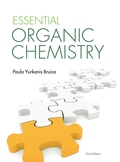
Concept explainers
Interpretation:
Compound A and B has to be identified using the given
Concept introduction:
The signal in the spectrum of a compound is proportional to the number of carbons that are present in the different environment within the molecule. The carbon which is present in the electron-rich environment shows a signal at a lower frequency and vice-versa. Therefore, the carbon that is present nearest to the electron-withdrawing groups produces a high-frequency signal.
The
The coupling between the carbon and the protons attached to it is called heteronuclear coupling.
Want to see the full answer?
Check out a sample textbook solution
Chapter 10 Solutions
EBK ESSENTIAL ORGANIC CHEMISTRY
- Explain the difference between the propagated uncertainty and the standard deviation. Which number would you use to describe the uncertainty in the measurement? if the standard deviation is 0.01 and the propagated uncertainty is 0.03arrow_forwardPropagation of uncertainty. Find the absolute and percent relative uncertainty assuming the ±-values are random error. 7.65±0.04 + 5.28±0.02 – 1.12±0.01 85.6±0.9 × 50.2±0.7 ÷ 13.8±0.5 [4.88±0.07 + 3.22±0.05] / 1.53±0.02arrow_forwardExplain the difference between the propagated uncertainty and the standard deviation. Which number would you use to describe the uncertainty in the measurement?arrow_forward
- Circle the compound in each pair where the indicated bond vibrates at higher frequency. WHY IS THIS? Provide thorough explanation to tie topic.arrow_forwardHow can you distinguish between each pair of compounds below using IR? Cite a bond and frequency that can be used to distinguish. Provide thorough steps and explanation.arrow_forwardPropagation of uncertainty. Find the absolute and percent relative uncertainty assuming the ±-values are random error. 65±0.04 + 5.28±0.02 – 1.12±0.01 6±0.9 × 50.2±0.7 ÷ 13.8±0.5 [4.88±0.07 + 3.22±0.05] / 1.53±0.02arrow_forward
- Match to correct spectrum and explain the bonds and frequencies used to tell what spectrum connected to the given option. Thanks.arrow_forwardDraw the virtual orbitals for the planar and pyramidal forms of CH3 and for the linear and bent forms of CH2arrow_forwardQ2: Draw the molecules based on the provided nomenclatures below: (2R,3S)-2-chloro-3-methylpentane: (2S, 2R)-2-hydroxyl-3,6-dimethylheptane:arrow_forward
- Q3: Describes the relationship (identical, constitutional isomers, enantiomers or diastereomers) of each pair of compounds below. ག H CH3 OH OH CH3 H3C OH OH OH ////////// C CH3 CH3 CH3 CH3 H3C CH 3 C/III..... Physics & Astronomy www.physics.northweste COOH H нош..... H 2 OH HO CH3 HOOC H CH3 CH3 CH3 Br. H H Br and H H H Harrow_forwardQ1: For each molecule, assign each stereocenter as R or S. Circle the meso compounds. Label each compound as chiral or achiral. OH HO CI Br H CI CI Br CI CI Xf x f g Br D OH Br Br H₂N R. IN Ill I -N S OMe D II H CO₂H 1/111 DuckDuckGarrow_forwardThese are synthesis questions. You need to show how the starting material can be converted into the product(s) shown. You may use any reactions we have learned. Show all the reagents you need. Show each molecule synthesized along the way and be sure to pay attention to the regiochemistry and stereochemistry preferences for each reaction. If a racemic molecule is made along the way, you need to draw both enantiomers and label the mixture as "racemic". All of the carbon atoms of the products must come from the starting material! ? H Harrow_forward
 Organic ChemistryChemistryISBN:9781305580350Author:William H. Brown, Brent L. Iverson, Eric Anslyn, Christopher S. FootePublisher:Cengage Learning
Organic ChemistryChemistryISBN:9781305580350Author:William H. Brown, Brent L. Iverson, Eric Anslyn, Christopher S. FootePublisher:Cengage Learning
